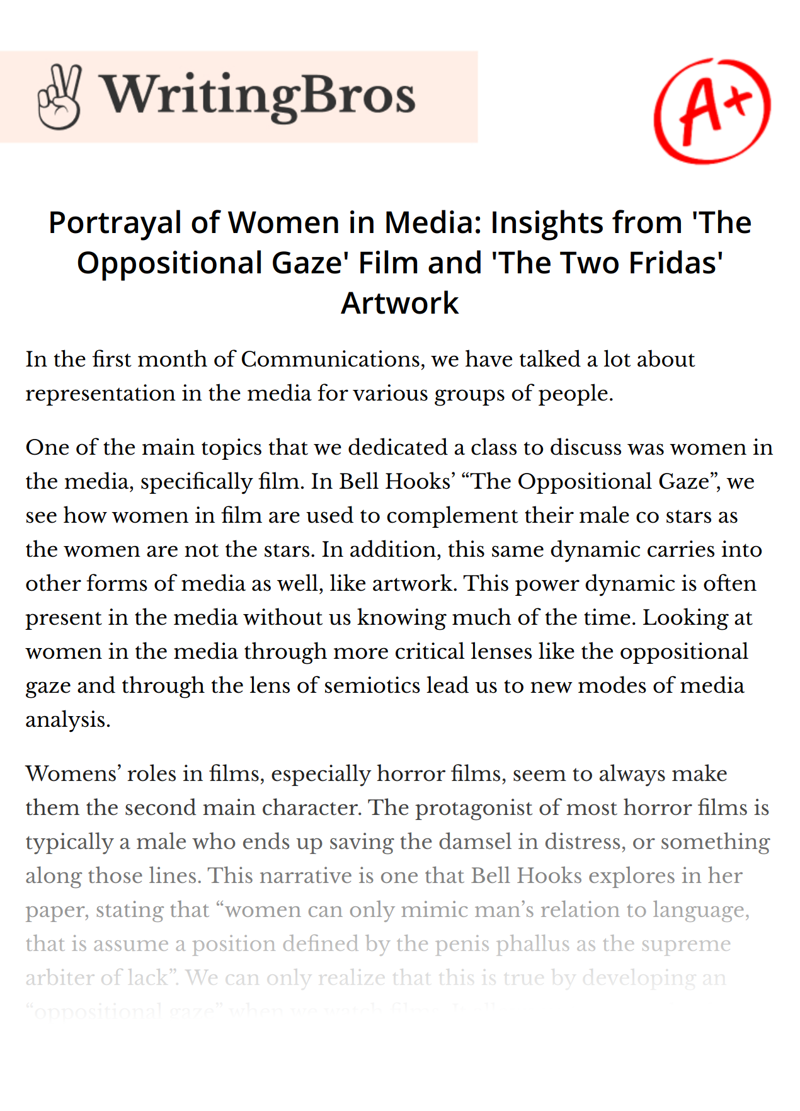Portrayal of Women in Media: Insights from 'The Oppositional Gaze' Film and 'The Two Fridas' Artwork

In the first month of Communications, we have talked a lot about representation in the media for various groups of people.
One of the main topics that we dedicated a class to discuss was women in the media, specifically film. In Bell Hooks’ “The Oppositional Gaze”, we see how women in film are used to complement their male co stars as the women are not the stars. In addition, this same dynamic carries into other forms of media as well, like artwork. This power dynamic is often present in the media without us knowing much of the time. Looking at women in the media through more critical lenses like the oppositional gaze and through the lens of semiotics lead us to new modes of media analysis.
Womens’ roles in films, especially horror films, seem to always make them the second main character. The protagonist of most horror films is typically a male who ends up saving the damsel in distress, or something along those lines. This narrative is one that Bell Hooks explores in her paper, stating that “women can only mimic man’s relation to language, that is assume a position defined by the penis phallus as the supreme arbiter of lack”. We can only realize that this is true by developing an “oppositional gaze” when we watch films. It allows us to more clearly look at power relations in general, not just with women in film. This perspective promotes watching film in a much more engaging way than simply watching women be the victim of a serial killer as many horror films present.
Another example of women in the media is in artwork, specifically, Frida Kahlo’s The Two Fridas. Although this painting was produced by a woman, the subjects of the painting are both connected to a man via a small portrait being held by the woman on the right. Both she and the woman on the left have bodily veins attached to this portrait, using it as a sort of lifeline. As we learned in Sean Hall’s “Signs and Signing”, this image represents something much deeper than what most people pick up on the surface. Looking at the signs and signifiers in the painting, one of the most striking images is that of the Frida on the left having her white dress soiled by blood.
The blood is dripping from the artery connected to the man’s picture, which suggests that this is a sign of her loss of innocence to this man. The Frida on the right is not connected to a real body, she is connected to a representation of a body. However, both Fridas appear to be relying on a man in some way, just as Hooks had brought attention to in the reading. In order for one to see these symbols and signifiers, they have to look through another lense, one that is ready to analyze these elements of media. Semiotics, or the study of meaning, helps us to more critically look at artwork like this by giving us signs and symbols to look for.
The majority of people go through life without thinking twice about these critical perspectives that we should be looking at the media through. They instead watch these films, or look at pieces of artwork on the surface level, and not at the analytical level that raises questions about power imbalances between men and women.
Cite this Essay
To export a reference to this article please select a referencing style below

